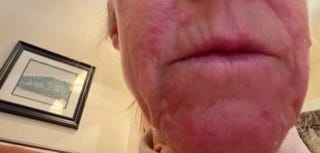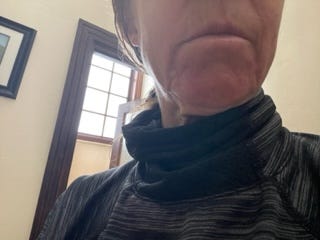My before and after facial skin pictures; does your doctor test for this and why they should
I had unknown skin issues so check out the 3 month differences, this test is often not run but it offers useful information
My Before and After Skin Pictures
Picture one is from December 2, 2022, and Picture two is from February 14, 2023. Both are with no makeup. The first picture shows how red and irritated my skin is. The doctor said it could be rosacea but wasn’t sure. I have never had rosacea in the past. My doctor prescribed a topical medication. I purchased it, but I never used it.
If you have been reading my substack, you know that I decided to hit it with numerous supplements and protocols. Changing my diet for 3 months did not help-I took out foods I eat daily, such as cashews and almonds, and I took out all nightshades and all snack foods to reduce inflammatory foods in my diet. I saw no change. I then removed any newer supplements that I added to my regimen-no change.
Two weeks after adding in skin supplements and doing a candida and heavy metal cleanse, I saw a huge improvement-the redness and inflammation were reduced drastically.
I added a home air purifier in the bedroom and put castor oil on my face at bedtime.
It took about 2 months for the bumps to disappear, and they are still very slightly there on my right side.
I still am unsure why I was getting this skin issue, but I understand how one can feel so self-conscious when they look like this. Even with makeup, you could see it. I was getting so embarrassed that even when I went for runs, I was putting on foundation, something I normally would not do.
I stopped all the protocols and supplements two weeks ago, and so far, so good. I continue putting the castor oil on nightly as my skin is much smoother and softer since I have applied it.
I have always had sensitive skin and have the autoimmune condition psoriasis, but I have not had a severe outbreak of it in over 20 years.
If you have a troublesome skin issue, I may be of help-contact me for more information about my services.
Homocysteine. What this lab marker tells you and why its important

This lab marker indicates cardiovascular disease risk or low B vitamin intake. If elevated, along with a low omega-3 index may indicate CVD risk and potentially greater dementia risk.
Yet, it is not part of standard blood tests, even if you are at risk for CVD.
Homocysteine is an amino acid linked to CVD and, when elevated, can cause damage to the arterial lining and cause blood clotting. When homocysteine stays elevated, the excess of this amino acid remains in the blood causing arterial damage (Ganguly & Alam, 2015).
Elevated homocysteine can be attributed to low folate levels, a nutrient in leafy greens. Adequate intake of B vitamins such as folate helps the body break down homocysteine and convert it to other products the body needs. Therefore, consuming leafy greens can assist with reducing levels of homocysteine in the blood.
This test may also be useful to indicate low B vitamins, which can contribute to depression signs and symptoms.
What is an optimal homocysteine range?
That may depend on who you ask. Integrative and Functional Medicine practitioners want to see it within a much smaller range, 5-9 umol/L
Low homocysteine is not as commonly seen, but it can indicate too much intake of methylated B vitamins, a low-fat diet, poor diet, absorption issues, or low stomach acid.
Reducing your homocysteine to support cardiovascular health includes balancing your meat and egg intake with fruit and vegetables, supplementing with folate 0.5 mg to 5 mg per day, taking B12 up to 1 mg daily, and getting your B12 levels tested too. Supplement with 5-25 mg of B6. You should be able to get all 3 in a B complex supplement. Lastly, it is helpful to know if you have the MTHFR gene mutation if you still continue to have elevated homocysteine.
Lab test reminder: If you do not have a patient portal to access all your prior test results, do not leave the medical office without a hard copy. Save all your medical test results. It will make it much easier on you when a different practitioner wants to review and compare lab tests.
Source
Ganguly, P., & Alam, S.F. (2015). Role of homocysteine in the development of cardiovascular disease. Nutrition Journal 14(6). https://doi.org/10.1186/1475-2891-14-6
If you need quality supplements, you can purchase them via my Fullscript Apothecary.
Go to https://trufoodsnutrition.com and click the arrow down tab across from resources to pull down the supplement tab. Click supplements, and it will take you to where you can register for Fullscript.




